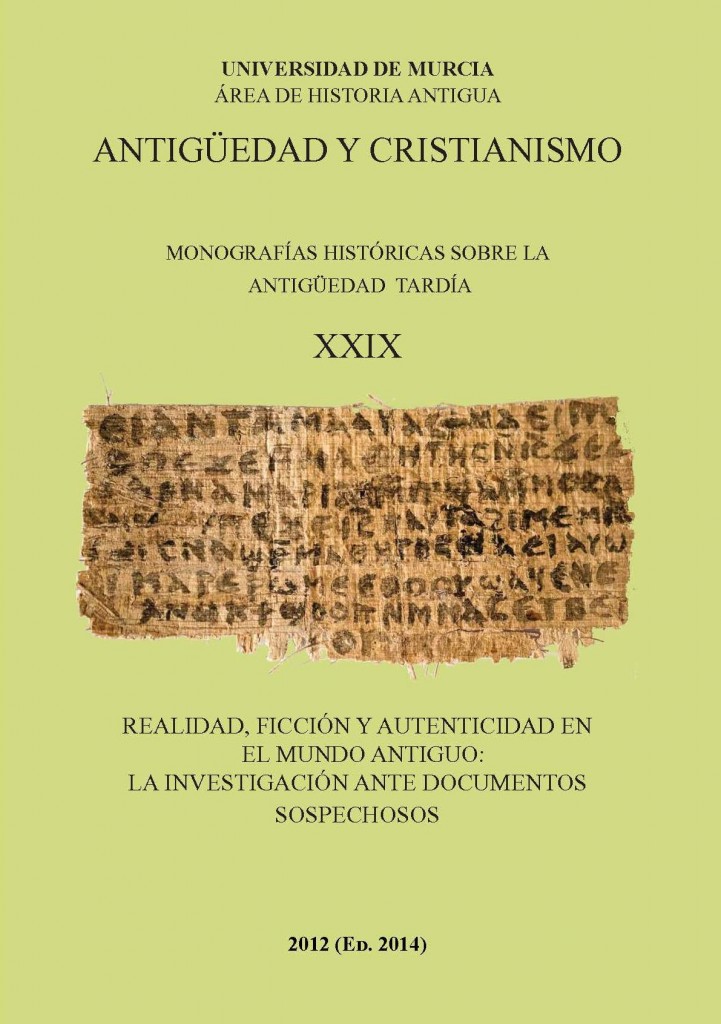Problemas en la detección de plagios antiguos y modernos
Supporting Agencies
- plagiarism
- structural plagiarism
- attic commedy
- Internet searchers
- metasearch Engine
- Search Algorithm
- Karl-Theodor zu Guttenberg
Abstract
This paper examines questions of plagiarism from Antiquity, focusing especially on the difficulties of plagiarism detection using software.Downloads
-
Abstract339
-
PDF (Español (España))159
References
A.E. HOUSMAN “The Application of Thought to Textual Criticism”, en The Classical Papers of A.E. Housman, Volume III: 1915-1936
C. WANKAT / F.S. OREOVICZ, Teaching engineering, New York 1992
E. Stemplinger, Das Plagiat in der griechischen Literatur, Berlin 1912
F. ROSCALLA, L’autore e l’opera: attribuzioni, appropriazioni, apocrifi nella Grecia antica, Roma 2006.
F. W. SPEYER, Die literarische Fälschung im heidnischen und christlichen Altertum: ein Versuch ihrer Deutung, München 1971, p. 15
H. PETER, Wahrheit und Kunst, Geschichtschreibung und Plagiat im klassischen Altertum, Leipzig/Berlin 1911
L. ADAM, Über die Unsicherheit literarischen Eigentums bei Griechen und Römern, Düsseldorf 1906
M. HAASE, “Linguistic Hacking. How to know what a text in an unknown language is about?”, en 24th Chaos Communication Congress, 2007, vid. http://events.ccc.de/congress/2007/Fahrplan/attachments/1026_LingHack-Slides.pdf.
M. HEATH, Political Comedy in Aristophanes, Göttingen 1987, p. 152.
M. SONNINO, “L’accusa di plagio nella commedia attica antica”, en Furto e plagio nella letteratura del Classicismo, Roberto Gigliucci (ed.), 423. Roma, 1998, pp. 19–51
M.F. Silva, “O plágio: um mal da comédia grega do séc. V a.C.?”, en Mundus vult decipi, Javier Martínez (ed.), Madrid 2012, pp. 379–388.
R.A. HARRIS / V. LOCKMAN, “Academic Integrity as an Institutional Issue”, Ethics and Behavior 2001, 11 (3): 325–342
R.A. HARRIS / V. LOCKMAN, The plagiarism handbook, Los Angeles 2001; B.E. WHITLEY / P. KEITH-SPIEGEL, Academic dishonesty: An educator’s guide, New York 2001
R.M. HOWARD, Standing in the shadow of giants: Plagiarists, authors, collaborators, New York 1999, así como “Understanding ‘Internet plagiarism’,Computers and Composition, 2007, 24(1), 3–15.
S. MCGILL, Plagiarism in Latin Literature, Houston 2012
STEIN / N. LIPKA / P. PRETTENHOFER, “Intrinsic Plagiarism Analysis”, Language Resources and Evaluation (LRE), 2011, 45(1), pp. 63–82.
WEBER-WULFF / G. WOHNSDORF, “Strategien der Plagiatsbekämpfung”, en Information: Wissenschaft & Praxis 57.2, 2006, pp. 90–98.
1. The authors non-exclusively assign the exploitation rights (reproduction, distribution, communication and transformation) to the magazine.
2. The works published in this magazine are subject to the Attribution-ShareAlike 4.0 International license (CC By SA 4.0). Therefore, they can be copied, used, disseminated, transmitted and publicly displayed, provided that:
i) the authorship and the original source of its publication (journal, editorial and URL of the work) are cited, thus allowing its recognition.
ii) it is allowed to remix, transform or create from the material while maintaining the same license as the original.
Note: Articles prior to 2022 incorrectly display the CC by SA license in the abstract page. They are under a CC by NC ND license as embedded in the article pdfs. Articles published in 2022 and after are under the CC by SA license.

3. Self-archiving conditions. Authors are allowed and encouraged to electronically disseminate the pre-print (version before being evaluated) and/or post-print (version evaluated and accepted for publication) versions of their works before publication, as it favors their publication. Earlier circulation and diffusion and with it a possible increase in its citation and reach among the academic community. Color RoMEO: verde.
























